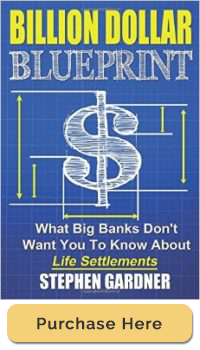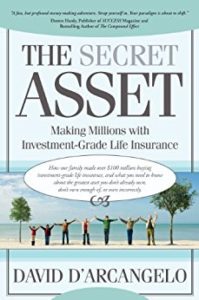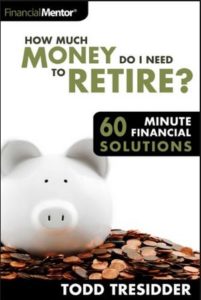Overall Impressions
Billion Dollar Blueprint: What Banks Don’t Want You to Know about Life Settlements by Stephen Gardner is a quick read, with some really helpful information about a little known asset – Life Settlements. For those unfamiliar with Life Settlements – which may be most of the population – these are simply contracts to purchase a Life Insurance policy from a policy owner.
Life Insurance is an asset, and ever since the Supreme Court ruled in 1911 that Life Insurance policies could be bought and sold as an asset, people have been doing so.
In the book, Gardner outlines exactly what Life Settlements are, how they are purchased, the benefit to both the buyer and seller, and the overall tax consequences of investing in these. The book has plenty of good information. Some chapters seem to say the same thing a few different ways to drive the facts home. For some it may be helpful, for me it was repetitive.
The Bottom Line
Billion Dollar Blueprint delivers a solid investment opportunity for anyone that has some cash reserves, or even a qualified account (401k, IRA or Roth IRA) that can be self-directed. He heavily critiques the “tried and true” method of investing in mutual funds or individual stocks as a healthy retirement vehicle. And his critiques are backed by some compelling data.
Finally, I don’t necessarily think this was intended by Gardner, but the book also showcases how an individual late in life can benefit from their life insurance policy without having to take the lower cash-out offers from the insurance companies. For anyone that has reservations about buying cash value life insurance because they are concerned about premium payments during their later years, life settlements are the answer.
Are Life Settlements a Good Investment?
Gardner tackles the big question right up front – are life settlements a good investment? He stresses two main goals in suggesting that the answer is “yes” to the question.
Number one goal, he considers time to be the most precious resource that anyone can have. It’s in limited supply and you can’t get more than you already have. So, if you can re-capture some of that time back by investing in life insurance, then it’s a big win. The time is captured by not having to watch the stock market and no longer worrying about economic trends and other market stresses. The guarantees of life settlements free up time for the individual and also deliver on the second main goal.
The second goal is to deliver more money to the investor. According to Gardner, life settlements do exactly that. In fact, he showcases that banks consider life insurance contracts to be such a great asset, that “as of 2012, banks owned a combined $137.95 billion worth of permanent life insurance. Bank of America being the largest, with most recent data reports showing $17.3 billion on their books.”
Gardner understands that many people today are still stuck in their old way of thinking and assume that the mainstream financial “gurus” are always right. But he cautions against listening to these financial “experts” and quotes the famous German philosopher Arthur Shopenhauer:
“All truth goes through three stages: It is ridiculed; then it is radically opposed; and only much later will it be accepted as self-evident.”
If Life Settlements are So Great, Why Haven’t I Heard About Them Before?
Gardner acknowledges that bank tellers at places like Wells Fargo will not even know what you are talking about if you ask about life settlements. And this is in spite of the fact that “Wells Fargo is one of the largest sponsors of Lisa.org which is the Life Insurance Settlement Association; an association that has been in business for 20 years helping seniors get the most out of their life settlement transactions.”
He also asks “Why has Merrill Lynch placed corporate money in life settlements for decades, but has never made the investment available to their retail clients?”
Gardner answers the question by saying that life settlements are the “goose that lays the golden eggs.” Banks have no incentive to advertise these assets. They already have access to them, and adding more investors would only increase competition in a market that wouldn’t see an increase in values with greater demand. In other words, the life insurance contracts have a fixed payout, regardless of the amount of people interested in buying the contract. So the increased competition would just reduce profits.
What is a Life Settlement, and How Does It Work?
“A life settlement is buying an older person out of their contract and collecting the death benefit proceeds. It’s a win for the seller and a win to the buyer.”
Gardner gives the following example of a typical life settlement transaction:
“We have an 89 year old female with predicted life expectancy of 40 months. If you put in $100,000 you are contractually obligated to receive $136,667 at payout. That means from day one you are buying into $36,667 in equity with a 40 month time frame of getting your money. The contract has a built-in return of 36.67% and over [the] predicted time frame will give an 11% or higher return.”
Three Investments With Instant Equity
Billion Dollar Blueprint praises the fact that life settlements are contracts in which you “walk into equity.” And Gardner suggests that there are really three main ways in which investors typically can find this favorable scenario. The first, and by far the most popular, is real estate. Buying and flipping homes is a way in which people believe they are walking into equity. The second is with zero coupon bonds, which Gardner explains as follows:
“A zero coupon bond is a bond which you buy at a discount that has a higher pay out in the future. Let’s say you bought a 20 year bond with a 5.5% discount. You would pay $6,757 for the bond. The bond is then held for 20 years with a final pay back of $20,000 or a 5.5% compounded growth for 20 years.”
And third is life settlements, which are life insurance contracts held on someone over the age of 65 that no longer wants to own their life insurance plan. This scenario happens for any number of reasons, but a common one is the beneficiaries for the policy may have died prematurely. So the insured may not have the incentive to give money away after death. Instead the insured may want to have the money now, even though it is an amount much lower than the total death benefit.
Insurance companies do offer policy holders the option to “cash-out,” but it is usually 3-5 times less money than can be acquired via a settlement. This means that the policy holder makes much more money on the sale, but the new owners are still getting instant equity.
The money that is used to purchase the contract is placed into an escrowed trust account – typically an irrevocable trust – and that money makes premium payments to keep the life insurance policy in force until the insured dies. When the insured dies, the death benefit is paid to the trustees.
Life Settlement Example
Gardner gives the following example of a life settlement contract.
“Let’s say you put $50,000 into a contract on an 84 year old man. The contract has a built in 44% return. You know from day one before you even buy into the contract that your money will be returned to you at the new amount of $72,000. $50,000 x 1.44 = $72,000. This is the contractual amount your money will increase to. Remember you know this from day one and it is contractual.”
The Disadvantages of Life Settlements
If there is a catch with life settlements, it’s the fact that the day of maturity is unknown. Gardner states that most contracts require funds to pay premiums for 7-8 years when the life expectancy is 3-4 years. The life expectancy is always calculated by actuarial firms, and you should be given access to this information by the life settlement company. The actuarial companies are highly accurate with large groups, but you may always get an individual that is an outlier.
If you do happen to buy into a contract in which the insured lives much longer than expected, you will be required to come up with additional money to pay the premiums. This can be a big deal for some because you have to have sufficient cash reserves to qualify to buy into life settlements for just such a contingency. But of course the qualifications are in line with the amount invested.
Expected Return of Life Settlements
“Keeping with the previous example of a 44% built-in return, if the contract matures in year one you will make a 44% return. If it matures in 2 years you make a 22% return. If it matures in 3 years you make 14.6%. If it goes to the 4th year it would be 44% divided by 4 years for an 11% return in each year and so on and so on with the math.”
Your return is always dependent on the death of the insured. In the example above, you are guaranteed to get $72,000 regardless of the time frame. You may get that money within a month, or it could take a year, two years, or 8 years. From day one you know what you’ll get, you just don’t know when you’ll get it.
Gardner seems to expect the concern that the returns may be really low if the insured individuals live much longer than expected. And he responds by stating that “From the Wall Street Journal, to Forbes Magazine, to Bloomberg, to the Huffington Post, to Affluent Magazine, to many University Studies, like the London School of Business or the Wharton School of business, all sources discuss the 12% or higher returns this asset class has provided.”
And Gardner adds that “according to a study completed by the University of London in 2013 on 9,002 life settlements contracts the University found the average expected return to be 12.5%.The 9,002 contracts represented $24.14 billion worth of contractual payouts.”
What About Fees?
Gardner starts off by heavily criticizing the hidden fees in the typical 401k and mutual fund environments. He states that with a 1% fee “the account earned $5,000 and the fee was $1,050. If we take the $1,050 divided by the $5,000 the calculator will show 21%. This means that the annual management fee ate 21% of your annual return. With the 2% fee $2,100 divided by $5,000 is 42% of your earnings.”
In sharp contrast, a typical fee on a life settlement account would be just a flat fee of $125 annually, regardless of the size of the investment. And for those that want to use qualified funds like an IRA or 401k to invest in life settlements, there is typically a custodial fee that ranges between $100 and $500.
What About Taxes?
“The largest tax benefit actually goes to the seller of the life insurance plan. The seller is able to receive a large portion of their lump sum completely tax free.”
For those that are planning on using qualified funds to purchase life settlements they will continue to defer taxes because the money is growing in a tax-deferred account. The dollars used to purchase the contracts were pre-tax dollars, so all money and growth in the account will be taxed down the road. This is typical for all qualified funds.
Keep in mind that Required Minimum Distribution (RMD) laws still apply when you reach the age of 70 1/2. Gardner recommends maintaining some liquidity in one of your qualified accounts as you approach this age.
For those that choose to use cash go buy the contracts, they will pay taxes as they earn the money. Which means that taxes will come due with each maturity.
By using qualified funds you are able to use pre-taxed dollars to go to work for you in the life settlement program. You simply move your funds to a self-directed account. Then you guide the account to buy into the contracts you feel will be best suited for you. This allows you to keep your money growing tax-deferred or tax delayed for a very long time. As you have maturities and see your account grow by 35-80% your money drops back into your account without creating a taxable event.
you will need to be conscious of the Required Minimum Distribution or RMDs at age 70 ½. As you near this age, you need to maintain liquidity in one of your qualified accounts to pay Uncle Sam his owed portion.
Gardner seems to be talking about life insurance with banking policies when he says the following:
“we can even show you how to use the money in your life insurance plan to earn interest in your account and how to make it earn interest in life settlements at the same time. This is a very advanced strategy, reserved for sophisticated investors”
I like the fact that Gardner thinks infinite banking is sophisticated investing, but I don’t think it’s nearly as complicated as he’s leading people to believe. Then again, people are still stuffing their money under the mattress in mason jars.
Wrap-up
If you have never heard about life settlements, Gardner will likely make you a convert by the end of the book. He does an excellent job of walking the reader through all the questions and concerns that might arise. And he manages to add a boat load of data to back up his claims and opinions. Billion Dollar Blueprint is much of what it hopes to be in the title, a blueprint to making a tremendous amount of money.
Gardner concludes his book with a strong call to action in this quote from Tony Robbins:
“Make it a must that whenever you hear about something, read or research something you think has value for your life, don’t let it become knowledge. Convert it into action, for it is through actions that our destiny is shaped.”
Here at I&E we agree with Mr. Robbins, if you are interested in using life settlements as part of your holistic plan for wealth building and legacy creation, contact us. We’d love to provide you with a free consultation to go over your options for greater financial planning.






